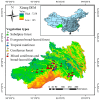Effects of Environmental Factors on the Diversity of Grasshopper Communities along Altitude Gradients in Xizang, China
- PMID: 39336639
- PMCID: PMC11432001
- DOI: 10.3390/insects15090671
Effects of Environmental Factors on the Diversity of Grasshopper Communities along Altitude Gradients in Xizang, China
Abstract
To determine the grasshopper species composition, altitudinal distribution patterns, and their main drivers, we conducted a study in Xizang using 33 sample plots ranging from 600 to 4100 m. Grasshoppers were collected from August to October during 2020-2022 using sweep nets. A total of 1159 grasshoppers from six families, 28 genera, and 44 species were identified, with Omocestus cuonaensis and Aserratus eminifrontus as the dominant species, comprising 30.03% and 10.26% of total grasshoppers, respectively. The results showed that species richness and the Margalef richness index of grasshopper communities decreased significantly (p < 0.05) with increasing altitude, peaking at 1100-1600 m and lowest values at 2600-3100 m. Similarly, the Shannon-Wiener index and Simpson dominance index also decreased significantly (p < 0.05) with an increase in altitude, showing the highest and lowest values at 600-1100 m and 3100-3600 m, respectively. The Jaccard similarity coefficients among grasshopper communities varied from 0 to 0.40 across altitudinal gradients, indicating different degrees of dissimilarity. The results of Pearson correlation analyses showed that the Shannon-Wiener index, species richness, Margalef richness index, and Simpson dominance index of grasshopper communities were significantly negatively correlated with the temperature factors and soil pH, but they were significantly positively correlated with the moisture factors. Hierarchical partitioning identified annual mean temperature-daily difference, precipitation in the coldest season, and driest month precipitation as the primary factors explaining variance in grasshopper community diversity in Xizang. These findings provided greater insights into the mechanisms underlying insect community structure, distribution patterns, and diversity in Xizang ecosystems, including implications for the effects of global warming on insect communities.
Keywords: Xizang; altitudinal gradient; distribution pattern; driving factors; grasshopper community structure.
Conflict of interest statement
The authors declare no conflicts of interest.
Figures









References
-
- Maguire D.Y., James P.M.A., Buddle C.M., Bennett E.M. Landscape connectivity and insect herbivory: A framework for understanding tradeoffs among ecosystem services. Glob. Ecol. Conserv. 2015;4:73–84. doi: 10.1016/j.gecco.2015.05.006. - DOI
-
- Shao X., Zhang Q., Yang X. Spatial patterns of insect herbivory within a forest landscape: The role of soil type and forest stratum. For. Ecosyst. 2021;8:69. doi: 10.1186/s40663-021-00347-3. - DOI
-
- Kati V., Zografou K., Tzirkalli E., Chitos T., Willemse L. Butterfly and grasshopper diversity patterns in humid Mediterranean grasslands: The roles of disturbance and environmental factors. J. Insect. Conserv. 2012;16:807–818. doi: 10.1007/s10841-012-9467-2. - DOI
LinkOut - more resources
Full Text Sources

